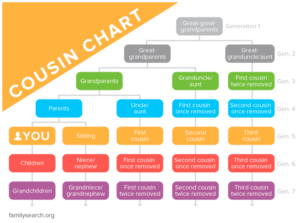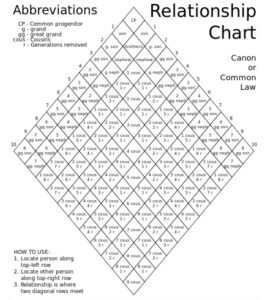from
AncestralFindings.com
4/1/20
(Click on charts to enlarge/use back arrow to return)
Do you know your cousins? Not the cousins you grew up with, but the many cousins you are going to encounter in your genealogical research? Once you get far enough into your genealogy research, you will be faced with a list of cousins of varying degrees of closeness to you. Making sense of just how close those cousins are to you is key to understanding your family tree as a whole, as well as where those cousins fall on it. Knowing your exact cousin relationship can also help you verify DNA matches if you do DNA testing.
You will probably hear the term “removed,” as well as a variety of numbers in association with cousin relationships when reading about genealogy. These relationships are significant to your research. Your first cousin three times removed, your second cousin one time removed, your third cousin four times removed and more are all meaningful relationships. But what do they mean, and how do you figure out just how you are connected to a particular cousin?
It’s easy! Once you have the particular technique down, you can figure out exact cousin relationships in your head. Cousin relationships that go back farther in time can be worked out by drawing a chart and counting. You will amaze your friends and relatives with your newfound cousin calculating ability, and your genealogy research will become a lot easier and more meaningful to you. It’s a must-have skill for any serious genealogist.
How Do You Start? Calculating a cousin relationship starts with your most common shared ancestor. This may be a grandparent or a 25x great-grandparent (or anything in between or beyond). Once you have the shared common ancestor between you and a cousin, you can figure out your precise cousin relationship with ease. It’s all a matter of generations.
Counting Generations – Your shared common ancestor had children. The children of those children are first cousins, also known as Generation 1. The children of first cousins are second cousins, or Generation 2. The children of second cousins are third cousins, or Generation 3, and so on. So, for example, if your great-grandmother is the shared common ancestor with a cousin, look at where the two of you stand on the family tree. Say your great-grandparents had a daughter and a son. That daughter had a daughter, and the son had a son. The daughter of the daughter and the son of the son are first cousins. Say the daughter of the daughter is your mother. So, the son of the son and your mother are first cousins.
If the son of the son has a son, that makes you and that son second cousins because you share the same generation… Generation 2 from your common ancestor. If you and your second cousin each have a child, your children will be third cousins or Generation 3 from their common ancestor… your great grandmother. Cousins who share the same generation in the family are always a straight number in the cousin tree, with no “removed” required.
Counting the “Removed” Generations – When it comes to figuring out if you are “removed” from a cousin, you still count generations. It might actually be helpful to use a chart to do this, as it is easier to see how many generations removed you are from someone if you draw it on some paper. There are two methods of doing this. One involves generations before you, and one involves generations after you. Generations after you are easiest. Start with a cousin with whom you share a generation. If that cousin has a child, that child is one generation removed from you. If that cousin has a grandchild, the grandchild is two generations removed from you, and so on. So, if your third cousin has a child, that child is your third cousin once removed. The grandchild of your third cousin is your third cousin two times removed. Each additional generation that is added to the family on your cousin’s line is another generation removed from you. The same thing goes for your children in their own cousin relationships with your cousin’s children.
The child of your first cousin is your first cousin once removed. Your child is your first cousin once removed’s second cousin. Your grandchild is your first cousin once removed’s second cousin one time removed. Just count back the number of generations from where you and your straight numbered cousin connect.
Going back in time, it is the same process in reverse. Pick a distant ancestor. Count down the number of straight numbered cousins in the family line. Choose any straight numbered pair, then count up the number of generations removed you are from that person. For example, if you discover someone who is a third cousin to your grandmother, you are two generations away from that third cousin (your father or mother being one generation removed, then you). So you are a third cousin two times removed from your grandmother’s third cousin.
Once you learn to figure out which generations match up and then count the generations removed you or another person are from that matched generation of cousins, you’ve got the whole cousin thing figured out. It’s not really hard at all. Figuring out cousins is all just a matter of counting. Count the generations, and you’ve got your cousin relationship sorted.
Note: For further explanation and graphics, go to FamilySearch.org
Last revised 9/2/20
